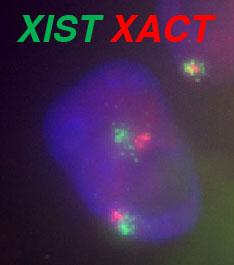
Submitted by Administrator on Mon, 23/01/2017 - 12:02
Affiliate PI Peter Rugg-Gunn's Lab at the Babraham Institute and researchers at the Paris Diderot University, Institut Curie report today in Cell Stem Cell that a second long RNA molecule, XACT, which exists in humans but not in mice, accumulates with XIST on active X-chromosomes in human embryos. The two RNAs do not overlap; instead XACT and XIST occupy large and distinct territories on the X-chromosome.
This study gives new insights into how one of the two X-chromosomes is silenced during the development of female human embryos and also in lab-grown stem cells. X-chromosome silencing is essential for proper development and these findings are important for understanding how the activity of the X-chromosome is regulated to ensure the healthy development of human embryos.
Female cells have two X-chromosomes. One X-chromosome is shut down in the earliest stages of development preventing the duplicated expression of genes from both X-chromosomes. Previous work using mouse embryos showed that a long RNA molecule called Xist coats regions of the silenced X-chromosome. By latching on to the DNA, Xist recruits proteins that shut down the chromosome. However, although XIST is expressed in human embryos, X-chromosome silencing isn’t triggered until a few days later. The different observation in mouse and human embryos suggests that XIST is unable to fulfil the same role in humans as in mouse development. Until now, it was unclear why XIST does not inactivate the X-chromosome in human embryos, or what triggers X-chromosome silencing.
Read more: Babraham Institute
Publication details:
Vallot et al., (2016) XACT Noncoding RNA Competes with XIST in the Control of X Chromosome Activity during Human Early Development Cell Stem Cell DOI: 10.1016/j.stem.2016.10.014

